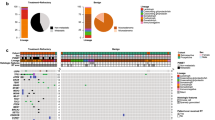Abstract
Oligodendrogliomas characterized and defined by 1p/19q co-deletion are slowly growing tumors showing better prognosis than astrocytomas. TP53 mutation is rare in oligodendrogliomas while the vast majority of astrocytomas harbor the mutation, making TP53 mutation mutually exclusive with 1p/19q codeletion in lower grade gliomas virtually. We report a case of 51-year-old woman with a left fronto-temporal oligodendroglioma that contained a small portion with a TP53 mutation, R248Q, at the initial surgery. On a first, slow-growing recurrence 29 months after radiation and nitrosourea-based chemotherapy, the patient underwent TMZ chemotherapy. The recurrent tumor responded well to TMZ but developed a rapid progression after 6 cycles as a malignant hypermutator tumor with a MSH6 mutation. Most of the recurrent tumor lacked typical oligodendroglioma morphology that was observed in the primary tumor, while it retained the IDH1 mutation and 1p/19q co-deletion. The identical TP53 mutation observed in the small portion of the primary tumor was universal in the recurrence. This case embodied the theoretically understandable clonal expansion of the TP53 mutation with additional mismatch repair gene dysfunction leading to hypermutator phenotype. It thus indicated that TP53 mutation in oligodendroglioma, although not common, may play a critical role in the development of hypermutator after TMZ treatment.




Similar content being viewed by others
Data availability
The data that support the findings of this study are available from the corresponding author on reasonable request.
References
Johnson BE, Mazor T, Hong C et al (2014) Mutational analysis reveals the origin and therapy-driven evolution of recurrent glioma. Science (New York, NY) 343(6167):189–193
Touat M, Li YY, Boynton AN et al (2020) Mechanisms and therapeutic implications of hypermutation in gliomas. Nature 580(7804):517–523
van Thuijl HF, Mazor T, Johnson BE et al (2015) Evolution of DNA repair defects during malignant progression of low-grade gliomas after temozolomide treatment. Acta Neuropathol 129(4):597–607
Yip S, Miao J, Cahill DP et al (2009) MSH6 mutations arise in glioblastomas during temozolomide therapy and mediate temozolomide resistance. Clin Cancer Res 15(14):4622–4629
Cairncross G, Wang M, Shaw E et al (2013) Phase III trial of chemoradiotherapy for anaplastic oligodendroglioma: long-term results of RTOG 9402. J Clin Oncol 31(3):337–343
Jaeckle KA, Ballman KV, van den Bent M et al (2021) CODEL: phase III study of RT, RT + TMZ, or TMZ for newly diagnosed 1p/19q codeleted oligodendroglioma. analysis from the initial study design. Neuro Oncol 23(3):457–467
Iwadate Y, Matsutani T, Hasegawa Y et al (2011) Favorable long-term outcome of low-grade oligodendrogliomas irrespective of 1p/19q status when treated without radiotherapy. J Neurooncol 102(3):443–449
Aihara K, Mukasa A, Nagae G et al (2017) Genetic and epigenetic stability of oligodendrogliomas at recurrence. Acta Neuropathol Commun 5(1):18
Choi S, Yu Y, Grimmer MR, Wahl M et al (2018) Temozolomide-associated hypermutation in gliomas. Neuro Oncol 20(10):1300–1309
Jones LE, Hilz S, Grimmer MR et al (2020) Patient-derived cells from recurrent tumors that model the evolution of IDH-mutant glioma. Neuro-oncol Adv 2(1):vdaa88
Brat DJ, Verhaak RG, Aldape KD et al (2015) Comprehensive, integrative genomic analysis of diffuse lower-grade gliomas. N Engl J Med 372(26):2481–2498
Suzuki H, Aoki K, Chiba K et al (2015) Mutational landscape and clonal architecture in grade II and III gliomas. Nat Genet 47(5):458–468
Cahill DP, Levine KK, Betensky RA et al (2007) Loss of the mismatch repair protein MSH6 in human glioblastomas is associated with tumor progression during temozolomide treatment. Clin Cancer Res 13(7):2038–2045
Acknowledgements
This study was partly supported by JSPS KAKENHI(Grant Number K2016390, F.H)
Author information
Authors and Affiliations
Corresponding author
Ethics declarations
Conflict of interest
The authors have no conflict of interest to declare.
Ethical approval
The patient and patient’s legal guardian signed consent under research protocol approved by Institutional Ethics Committee of Dokkyo Medical University(reference number:R-21-10 J).
Additional information
Publisher's Note
Springer Nature remains neutral with regard to jurisdictional claims in published maps and institutional affiliations.
Supplementary Information
Below is the link to the electronic supplementary material.
Rights and permissions
Springer Nature or its licensor (e.g. a society or other partner) holds exclusive rights to this article under a publishing agreement with the author(s) or other rightsholder(s); author self-archiving of the accepted manuscript version of this article is solely governed by the terms of such publishing agreement and applicable law.
About this article
Cite this article
Higuchi, F., Uzuka, T., Matsuda, H. et al. Rise of oligodendroglioma hypermutator phenotype from a subclone harboring TP53 mutation after TMZ treatment. Brain Tumor Pathol 41, 80–84 (2024). https://doi.org/10.1007/s10014-024-00477-w
Received:
Accepted:
Published:
Issue Date:
DOI: https://doi.org/10.1007/s10014-024-00477-w




